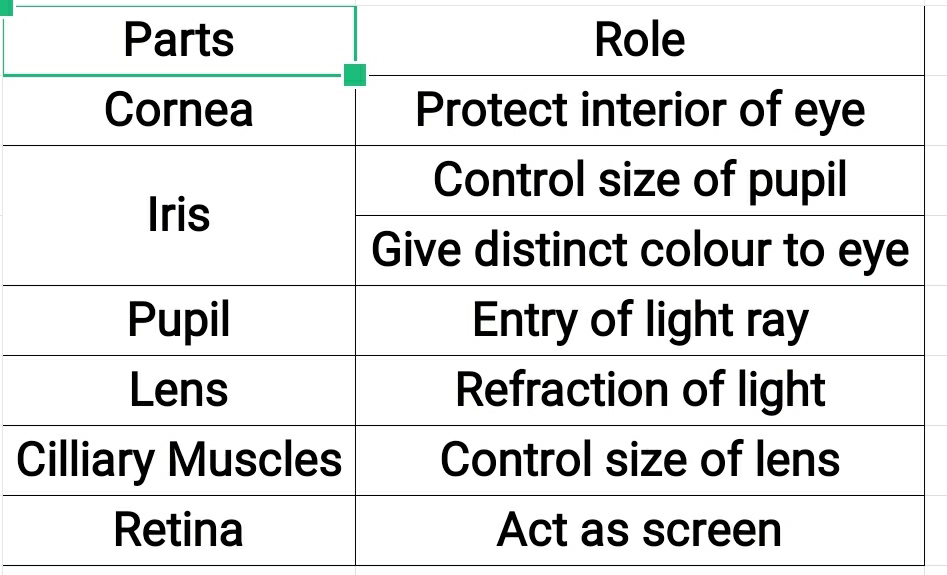Cell - Structure and Functions NCERT Science Class 8 Chapter 8 Summary Note
Cell - Structure and Functions
*Cell-
Structural and functional unit of life, is called cell.
* Discovery of cell
- Discovered by - Robert Hooke- Used - Thin slice of cork.
- Cork - Part of bark of a tree
* Egg of a hen represent single cell.
* Multicellular organism
-Organism made of more than one cells, is called multicellular organism.
- Example- Human
- Multicellular organism begins life as a single cell.
*Unicellular organism
- Single celled organism are called unicellular organism.
- Example- Amoeba
* Shape of cells
Cell Shape
Amoeba,
WBC(White Blood Cell) Irregular shape
Muscle cell Spindle shape
RBC Spherical
Nerve cell Branched shape
*Pseudopodia - (Pseudo- False, Podia- Foots)
-Protruding out projections on body of amoeba, is called pseudopodia.
-Pseudopodia appear and disappear as amoeba moves or feeds.
* WBC(White Blood Cell) Vs Amoeba
- White Blood Cell is a cell.
Amoeba is also a cell.
- White Blood cell is not an organism.
Amoeba is a full fledge organism.
* Size of cells
- Smallest cell - Bacterial cell
- Largest cell - Ostrich egg
* Size of cells has no relation with size of body of animal or plant.
Size of cell is related to its function.
* How cell makes an organism?
Cell ----> Tissue ----> Organ ----> Organ system ----> Individual
* Parts of the cell -
- Cell membranes(Plasma membrane, Cell wall)
- Cytoplasm
- Nucleus(Nuclear membrane, Chromosome, Nucleolus)
- Vacuole
- Plastid (Chloroplast)
* Cell membrane or Plasma membrane
- Cover of cell is called cell membrane
- Cell membrane separates cell from surrounding.
- It allows movement of substances both inward and outward.
* Cell wall
-Outer thick layer present on plant cell, is called cell wall.
- It protects cell against temperature, wind etc.
* Nucleus
-Dense body in center of cell, is nucleus.
- It consists of nuclear membrane, chromosome and nucleolus.
- Nuclear membrane- Outer cover of nucleus.
It separates nucleus from cytoplasm.
It allows movement of substances both inward and outward.
- Chromosome- Thread like structure in nucleus.
It carries gene.
It helps in inheritance (transfer of characters from parents to offspring)
- Role of nucleus
It control activities of cell.
It helps in inheritance.
It helps in cellular reproduction.
-Nucleolus
A smaller spherical body in nucleus.
* Cytoplasm
-Jelly like substance between nucleus and cell membrane, is called cytoplasm.
- It carries cell organelles(vacuole, plastid, etc.)
* Protoplasm
- Entire content of a living cell, is called protoplasm.
- Protoplasm = Cytoplasm + Nucleus
* Vacuole
- Sac like organelle.
- It store nutrients or waste.
* Plastid-
- Coloured bodies in cytoplasm of plant cell, is called plastid.
- Green plastid is called chloroplast.
- Chloroplast looks green due to chlorophylls in it.
- Chlorophyll is green pigment that do photosynthesis.
* Difference between plant cell and animal cell
Plant cell Animal cell
Cell wall is present. Cell wall is absent.
Plastid is present. Plastid is absent.
Vacuoles are larger in size.Vacuoles are smaller in size.
Vacuoles are lesser in number.Vacuoles are more in number.
* Difference between prokaryotic and eukaryotic cell
Prokaryotic cell Eukaryotic cell
Nuclear membrane is . Nuclear membrane is absent. present
Organelles are without .Organelles are with membrane. membrane.
Example- bacteria, . Example- All organism blue green algae other than bacteria and
blue green algae
* Diagram : Cells
Diagram : Plant cell and Animal cell


Comments
Post a Comment